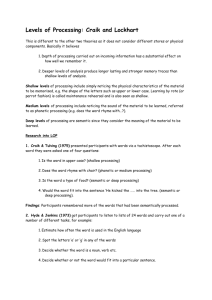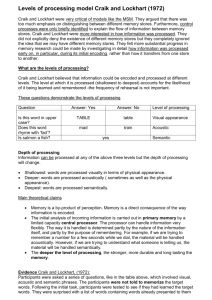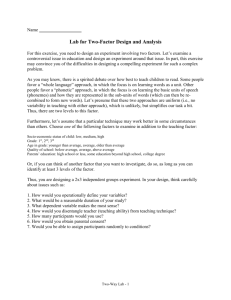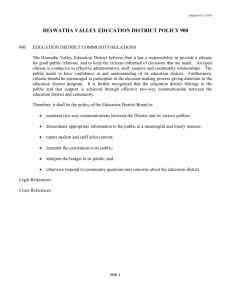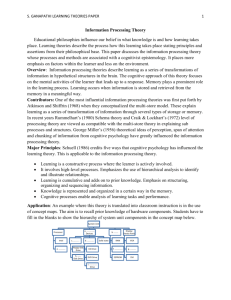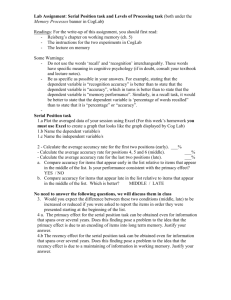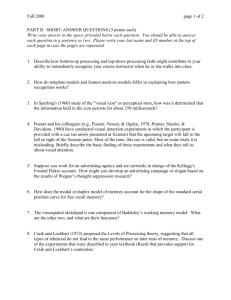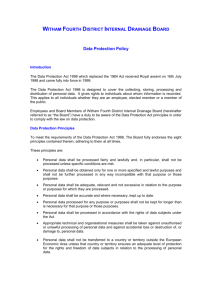The Cognitive System - Educational Psychology Interactive
advertisement
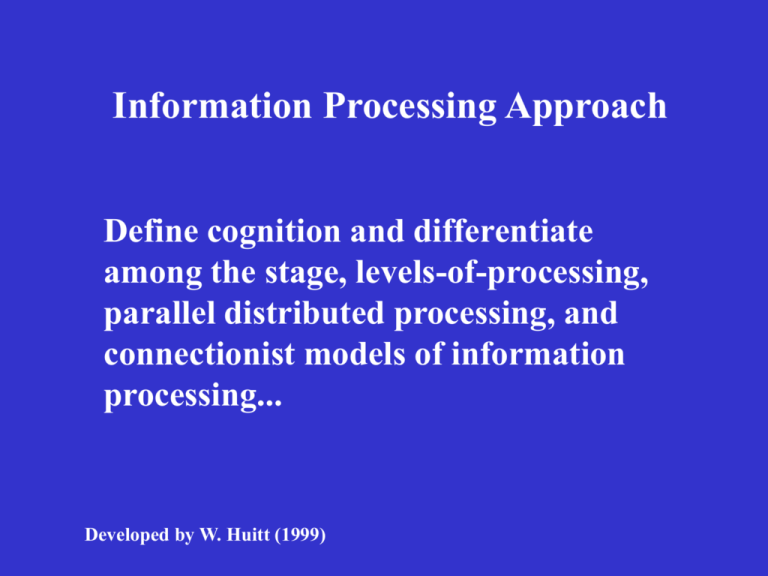
Information Processing Approach Define cognition and differentiate among the stage, levels-of-processing, parallel distributed processing, and connectionist models of information processing... Developed by W. Huitt (1999) The Cognitive System Cognition can be defined as "the act or process of knowing in the broadest sense; specifically, an intellectual process by which knowledge is gained from perception or ideas" (Webster's Dictionary). Information Processing Approach While cognitive psychology is the dominant school of thought today, the information processing approach is the dominant view within this area. The information processing approach focuses on the study of the structure and function of mental processing within specific contexts, environments, or ecologies. Information Processing Approach There are four major theories of how we humans process information: • Stage approach • Levels-of-processing theory • Parallel distributed processing theory • Connectionistic models The Stage Theory The focus of this model is on how information is stored in memory. The model is based on the work of Atkinson and Shriffin (1968) and proposes that information is processed and stored in three stages: • Sensory memory • Short-term memory • Long-term memory Atkinson, R., & Shiffrin, R. (1968). Human memory: A proposed system and its control processes. In K Spence & J Spence (Eds.). The psychology of learning and motivation: Advances in research and theory (Vol. 2). New York: Academic Press. The Levels-of-Processing Theory The Levels-of-Processing theory is based on the work of Craik and Lockhart (1972). The major proposition is all stimuli that activate a sensory receptor cell are permanently stored in memory. According to these researchers, the issue is not storage, but retrieval. Craik, F., & Lockhart, R. (1972). Levels of processing: A framework for memory research. Journal of Verbal Thinking and Verbal Behavior, 11, 671-684. . The Levels-of-Processing Theory Rather than hypothesize that information is processed in stages, Craik and Lockhart believe that retrieval of information is based on the amount of elaboration used as information is processed. This is done on a continuum from perception, through attention, to labeling, and finally meaning. Parallel Distributed Processing Theory The parallel-distributed processing model states that information is processed simultaneously by several different parts of the memory system, rather than sequentially as hypothesized by Atkinson-Shiffrin. The stage-theory model discussed in this course differs slightly from that first proposed by Atkinson and Shriffin in order to incorporate this principle. Connectionistic Theory The connectionistic model proposed by Rumelhart and McClelland (1986) extends the parallel-distributed processing model. This model emphasizes the fact that information is stored in multiple locations throughout the brain in the form of networks of connections. Rumelhart, D., & McClelland, J. (Eds.). (1986). Parallel distributed processing: Explorations in the microstructure of cognition. Cambridge, MA: MIT Press. Connectionistic Theory It is one of the dominant forms of current research in cognitive psychology and is consistent with the most recent brain research. It is also consistent with the levels-ofprocessing approach in that the more connections to a single idea or concept (i.e., the more extensively elaboration is used), the more likely it is to be remembered. The Information Processing Approach While there is much disagreement among the various schools of thought related to how human beings process information, there are a few general principles about which almost all researchers agree: The Information Processing Approach Limited capacity assumption The amount of information that can be actively processed by the system at a given point in time is constrained in some very important ways. The Information Processing Approach Limited capacity assumption Bottlenecks, or restrictions in the flow and processing of information, occur at very specific points. The Information Processing Approach Control mechanism Required to oversee the encoding, transformation, processing, storage, retrieval and utilization of information. The Information Processing Approach Control mechanism Not all of the processing capacity of the system is available; an executive function that oversees this process will use up some of this capability. The Information Processing Approach Control mechanism When one is learning a new task or is confronted with a new environment, the executive function requires more processing power than when one is doing a routine task or is in a familiar environment. The Information Processing Approach Two-way flow of information As we try to make sense of the world around us, we constantly use information that we • gather through the senses (often referred to as bottom-up processing) The Information Processing Approach Two-way flow of information As we try to make sense of the world around us, we constantly use information that we • information we have stored in memory (often called top-down processing) The Information Processing Approach Two-way flow of information This is a dynamic process that we use to construct meaning about our environment and our relations to it. The Information Processing Approach Two-way flow of information This principle is somewhat analogous to the difference between • inductive reasoning • deductive reasoning OR The Information Processing Approach Two-way flow of information This principle is somewhat analogous to the difference between • information we derive from the senses • information generated by our imaginations The Information Processing Approach Genetic preparation A human infant is more likely to look at a human face than any other stimulus. Language development is similar in all human infants. The Information Processing Approach Genetic preparation The human organism has been genetically prepared to process and organize information in specific ways. The Stage Theory We will focus on the stage theory in this course as work has been done to identify how to apply it to classroom and academic learning.
